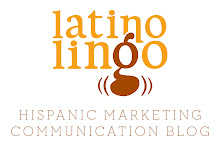No, you're not effectively reaching bicultural Latinos via the general market
The latest is, "Bicultural," a word they say is, "certainly the least understood and most poorly used in Hispanic advertising." Completely agree!
I thought I'd paste some of the definition to help squash the misconception out there that bicultural Hispanics are effectively reached via the general market. This misconception, routinely spread by many general market agencies to their clients, is a common headache for specialized Hispanic marketing agencies. Clients, who are trusting in the counsel of their agencies as they should, are misdirected into thinking their campaigns are reaching Hispanics and thus do not allocate any (or perhaps less than they should) resources to Hispanic market creative and Spanish-language media.
Here's part of Diestepedia's entry on "Bicultural":
Bicultural as Bilingual
Although these words are frequently used interchangeably, they are really quite different. Bicultural Hispanics have surpassed 60% of the population, according to Synovate, but people speaking English and Spanish (indiscriminately and with no preference for either) barely make up 20% of the population. While it's possible to be bicultural to some degree or another, you can either speak two languages perfectly or you cannot. However, this is just a theoretical difference. In practice, most research and marketing companies abandon the category of pure bilingualism by asking people for their language of preference. Then, they qualify anyone who can speak some degree of both English and Spanish as bilingual.One consequence here is that marketers tend to assume that bicultural Hispanics speak English fairly well. So, they ask why they should translate anything at all to Spanish. Well, maybe they shouldn't. In the "wiki-words" of an interactive expert: When a client asks me, "Why should I translate?" I answer, "You shouldn't. You should change your content, not your language, and give people options, because the freedom to choose how to interact with the world is the essence of being bicultural."


2 Comments:
At 11:31 AM , Joe G. said...
Joe G. said...
Es cierto. Si usted me escuchara hablar castellano, diría “¡Asombroso! ¡Ese tipo sí sabe los dos idiomas perfectamente! PERO, no me puedo expresar precisamente lo que quiero decir en español (tengo que pensar mucho en los detalles gramaticales antes de hablar), por otro lado es extremadamente fácil expresarme en inglés. ¡Mi mamá era profesor!
It’s true. If you were to hear me speak Spanish, you would say, “Amazing! That guy really knows both languages perfectly! HOWEVER, I cannot express exactly what I mean in Spanish (I have to think about the grammar details a lot before speaking). On the other hand, it is extremely easy to express myself in English. My mom was a teacher!
At 5:59 AM , Joe G. said...
Joe G. said...
Sometimes, you have to accept the fact that it is extremely difficult to express in a second language what took place in English. I find this again and again in translations of books and short stories that were originally written in English. Gone With The Wind had me laughing out loud because it seemed so absurd in Spanish; however, Spanish speakers around the world wanted to know the famous Margaret Mitchell story of the American Civil War. The novel’s characters’ English seemed obsolete (that’s how they talked in 1862!); still, the Spanish translation Lo que el viento se llevó has been popular for many years throughout Latin America and Spain.
Wilson Camelo is right. Think about it for about five seconds. How many cultures are represented by the 20+ Spanish-speaking countries in the western hemisphere? Within those 20 nations are many sub-cultures! Think of how culturally different the southeastern U.S. is than the northeastern U.S. Think of New York City itself – one city, a gazillion cultures!
It’s a big world out there, friends. Do yourself a favor and learn Spanish. You’ll start discovering new worlds.
Post a Comment
Subscribe to Post Comments [Atom]
<< Home